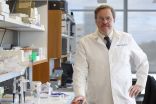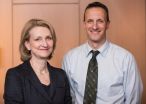Stem cell transplant without radiation or chemotherapy pre-treatment shows promise
Trial reports transplant success in dyskeratosis congenita, a rare bone marrow failure syndrome, following conditioning with immunosuppressive drugs alone
2014-12-07
(Press-News.org) SAN FRANCISCO (DECEMBER 7, 2014) - Researchers at Dana-Farber/Boston Children's Cancer and Blood Disorders Center report promising outcomes from a clinical trial with patients with a rare form of bone marrow failure who received a hematopoietic stem cell transplant (HSCT) after pre-treatment with immunosuppressive drugs only. This is the first trial reporting successful transplant in dyskeratosis congenita (DC) patients without the use of any radiation or conventional cytotoxic chemotherapy beforehand.
The trial's data were presented by study authors Leslie Lehmann, MD, and Suneet Agarwal, MD, PhD, of Dana-Farber/Boston Children's, at the 56th annual meeting of the American Society of Hematology (abstract #2941). The data suggest that this immunosuppression-only approach could benefit patients with DC--and, perhaps, other bone marrow failure syndromes--who are at high risk of poor transplant outcomes because they cannot tolerate the toxicity of conventional or even reduced-intensity conditioning.
All four participants in the study are alive and well between 10 and 27 months after transplant. None remain dependent on transfusions to maintain blood counts, nor did any experience significant unexpected toxicities or infections during or after transplantation. Were it not for this new regimen, one patient would have been ineligible for transplant due to severe DC-related lung disease.
Conventional transplant conditioning employs radiation and/or high-dose cytotoxic drugs (also known as alkylators) to destroy the bone marrow and blood and immune cells; it also causes widespread cellular damage throughout the body. The process prepares the patient's body to accept the donated stem cells, reducing the risk of rejection and providing a hospitable environment for the new cells to engraft, thrive and produce new blood and immune cells.
In DC and other bone marrow failure syndromes, however, the disease itself already weakens or destroys the patient's bone marrow, raising the question of whether a less toxic approach could effectively condition patients for transplant.
"These data show that it is possible to achieve engraftment within the context of DC using immunosuppression-only conditioning. This experience begs the question of whether we can think more broadly about this approach's applicability for other conditions, something I think is worth considering," Agarwal said.
"Bone marrow failure syndromes are problems of blood and immune cell production," he added. "In theory, then, in some of these conditions it should be possible for healthy donated stem cells to outcompete native cells, without exposing patients to the toxic effects of radiation or alkylating agents."
Eighty percent of patients with DC develop bone marrow failure before reaching age 30. The genetic defects underlying the disease prevent cells from maintaining their telomeres, the caps at the ends of chromosomes that gradually shorten as cells divide and a person ages. As a result, DC patients' hematopoietic stem cells age prematurely and do not divide well. While an HSCT can cure the resulting bone marrow failure, outcomes are often poor, likely because of the toxicity associated with conventional conditioning.
The cellular defects in DC created an opportunity for Agarwal and his collaborators to attempt immunosuppression-only pre-transplant conditioning. Tamping down a patient's immune system, they theorized, would give donor stem cells and their progeny a chance to outcompete the patient's existing cells with a minimal risk of rejection. At the same time, avoiding radiation and alkylators--which cause widespread cellular damage throughout the body--should reduce the risk of long-term HSCT-related complications, such as organ failure and cancer.
INFORMATION:
The research was funded by Boston Children's Hospital's Translational Research Program.
The Dana-Farber/Boston Children's Cancer and Blood Disorders Center--the nation's #1 pediatric cancer program, according to US News & World Report 2014-15--brings together two internationally known research and teaching institutions that have provided comprehensive care for pediatric oncology and hematology patients since 1947. The Harvard Medical School affiliates share a clinical staff that delivers inpatient care and surgery at Boston Children's Hospital, most outpatient care at Dana-Farber Cancer Institute.
[Attachments] See images for this press release:

ELSE PRESS RELEASES FROM THIS DATE:
2014-12-07
(SAN FRANCISCO, DECEMBER 7, 2014) - Recognizing that leukemia cannot be conquered with a "one-size-fits-all" approach, researchers are pursuing novel targeted therapies and combinations of existing treatment regimens with new agents for patient populations with historically poor prognoses, according to data presented today during the 56th American Society of Hematology (ASH) Annual Meeting and Exposition.
In recent years, outcomes for patients with leukemia have steadily improved with the emergence of numerous therapies that target specific genetic drivers of disease, ...
2014-12-07
SAN FRANCISCO, CA, December 7, 2014--A new type of cancer therapy that targets an oncometabolite produced dramatic results in patients with advanced leukemia in an early-phase clinical trial. The study, led by Eytan M. Stein, MD, a medical oncologist at Memorial Sloan Kettering Cancer Center, was presented today at the 56th Annual Meeting of the American Society of Hematology.
Approximately 15 percent of acute myeloid leukemia patients have a mutated form of the IDH2 gene. IDH2 normally makes a protein that plays a critical role in cell metabolism. However, when the gene ...
2014-12-07
UNSW Australia's solar researchers have converted over 40% of the sunlight hitting a solar system into electricity, the highest efficiency ever reported.
The record efficiency was achieved in outdoor tests in Sydney, before being independently confirmed by the National Renewable Energy Laboratory (NREL) at their outdoor test facility in the United States.
The work was funded by the Australian Renewable Energy Agency (ARENA) and supported by the Australia-US Institute for Advanced Photovoltaics (AUSIAPV).
"This is the highest efficiency ever reported for sunlight conversion ...
2014-12-07
The "molecular mail" sent by multiple myeloma cells provides clues to how well patients with the disease are likely to respond to treatment, according to a study being presented at the annual meeting of the American Society of Hematology (ASH) by researchers at Dana-Farber Cancer Institute.
The findings - to be presented in poster form on December 6, from 5:30 PM to 7:30 PM, in the West Building, Level 1 - may ultimately guide doctors in deciding which therapies are best for individual patients with myeloma, the study authors say.
The study focused on ...
2014-12-06
An innovative cell therapy against a highly aggressive form of acute lymphoblastic leukemia (ALL) continues to show highly promising results in children treated in a pilot study. Ninety-two percent of the 39 children receiving bioengineered T cells had no evidence of cancer at one month after treatment, with this complete response persisting in some cases for more than two years. The personalized cell therapy reprograms a patient's immune system and offers the potential of long-term success.
"As we continue to follow children in this study, we see exciting results for ...
2014-12-06
SAN FRANCISCO - A therapy that liberates the immune system to attack cancer cells drove Hodgkin lymphoma (HL) into complete or partial remission in fully 87 percent of patients with resistant forms of the disease who participated in an early-phase clinical trial, investigators at Dana-Farber Cancer Institute and partnering institutions report in a study published today in the New England Journal of Medicine and simultaneously presented at the annual meeting of the American Society of Hematology (ASH) in San Francisco.
The results provide some of the most dramatic evidence ...
2014-12-06
SAN FRANCISCO, CA, December 6, 2014--In recent years, a number of scientific breakthroughs have led to the development of drugs that unleash the power of the immune system to recognize and attack cancer. Studies presented today at the 56th Annual Meeting of the American Society of Hematology (ASH) highlight the enormous potential these novel treatments have for patients with a variety of hematologic disorders.
For Classical Hodgkin lymphoma (cHL) patients, two phase I studies are already demonstrating dramatic results. A study led by Craig H. Moskowitz, MD, Clinical ...
2014-12-06
PHOENIX -- In the treatment of multiple myeloma, the addition of carfilzomib to a currently accepted two-drug combination produced significantly better results than using the two drugs alone, according to a worldwide research team led by investigators from Mayo Clinic.
Their findings will be reported online Dec. 6 in the New England Journal of Medicine, and presented on Dec. 7 at the annual meeting of the American Society of Hematology (ASH), held in San Francisco.
Interim analysis of the ASPIRE clinical trial, which enrolled 792 patients with relapsed multiple myeloma ...
2014-12-06
SAN FRANCISCO, CA, December 6, 2014--In a late-stage clinical trial, Hodgkin lymphoma (HL) patients who received brentuximab vedotin (BV) post-transplant lived longer without disease progression than patients who received only supportive care. This is the first time a study has demonstrated that adding a maintenance therapy after transplant can improve outcomes. The study, led by Craig H. Moskowitz, MD, Clinical Director of the Division of Hematologic Oncology at Memorial Sloan Kettering Cancer Center, was presented today at the 56th Annual Meeting of the American Society ...
2014-12-05
COLUMBIA, Mo. - Unconventional oil and gas (UOG) operations combine directional drilling and hydraulic fracturing, or "fracking," to release natural gas from underground rock. Recent discussions have centered on potential air and water pollution from chemicals used in these processes and how it affects the more than 15 million Americans living within one mile of UOG operations. Now, Susan C. Nagel, a researcher with the University of Missouri, and national colleagues have conducted the largest review to date of research centered on fracking byproducts and their effects ...
LAST 30 PRESS RELEASES:
[Press-News.org] Stem cell transplant without radiation or chemotherapy pre-treatment shows promise
Trial reports transplant success in dyskeratosis congenita, a rare bone marrow failure syndrome, following conditioning with immunosuppressive drugs alone



